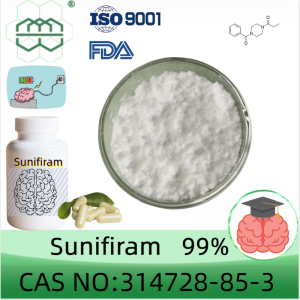BAM15 CAS No.:210302-17-3 Build muscle and lose weight.
Product Parameters
| Product name | BAM15 |
| Other name | N5,N6-Bis(2-fluorophenyl)[1,2,5]oxadiazolo[3,4-b]pyrazine-5,6-diamine |
| CAS No. | 210302-17-3 |
| Molecular formula | C₁₆H₁₀F₂N₆O |
| Molecular weight | 340.29 |
| Purity | 98% |
| Appearance | Off-white to light yellow powder |
| Packing | 1kg/bag, 25kg/barrel |
| Application | Dietary Supplement Raw Material |
Product introduction
BAM15 is a novel mitochondrial proton carrier uncoupling agent. By disrupting the proton gradient of the inner mitochondrial membrane, it significantly enhances energy consumption and promotes fat oxidation without affecting muscle or appetite. Preclinical studies have shown that it can effectively reverse obesity, improve insulin sensitivity, and reduce lipid accumulation and inflammation in the liver. The oral bioavailability reaches 67%, and its safety is superior to that of traditional uncoupling agents. It has no risk of high fever or cytotoxicity and is a potential candidate drug for the treatment of metabolic diseases.
Feature
(1) High purity: BAM15 can produce high-purity products through a refined production process. High purity means better bioavailability.
(2) Efficient uncoupling mechanism: As a mitochondrial proton carrier, it disrupts the proton gradient of the inner mitochondrial membrane, promoting the conversion of oxidative energy from nutrients into thermal energy rather than ATP, significantly enhancing energy consumption
(3) Safe fat loss and metabolic improvement: In animal experiments, the oral bioavailability reached 67%, reducing body fat by more than 20% without reducing muscle mass, affecting appetite or body temperature, while improving insulin sensitivity, alleviating fatty liver and inflammation
(4) Low toxicity advantage: Compared with traditional uncoupling agents, there is no risk of high fever or cytotoxicity. It remains safe at a high dose of 50μM, with no organ damage or neurological side effects.
Applications
1. Fat reduction and metabolic improvement: Through mitochondrial uncoupling, it significantly reduces body fat (in animal models, body fat decreases by more than 20%), simultaneously lowers blood sugar, insulin resistance, and liver fat accumulation, without affecting appetite or muscle mass;
2. Anti-aging: Enhance muscle mass (by 8%) and strength (by 40%) in elderly animals, reduce fat and inhibit chronic inflammation, and combat myogenic obesity.
3. Anti-inflammatory: Reduces the risk of sepsis-induced acute kidney injury (AKI), and alleviates systemic inflammatory responses by inhibiting mitochondrial ROS production and mtDNA release.
















